The skin is a complex and highly effective organ (Fig. 1) that protects our body and makes it attractive. It is a barrier – but also intermediate station for outgoing and incoming substances. A healthy skin and in particular the outward, topmost layer, called epidermis, is a dynamic system that continually adjusts to the changing environmental conditions:
- It controls the thermal output and -absorption – depending on the external temperature and muscular activity.
- It controls the evaporation depending on the temperature, air humidity and muscular activity – in "normal conditions“ about 0.5 to 1 litre per day. Together with the water also salts are excreted via sweat glands.
- It excretes lipid substances via the sebum of the sebaceous glands – build-up of the lipid mantle of the skin.
- It forms a barrier against foreign substances and microorganisms and also maintains the low pH value of the skin surface – the acid mantle of the skin.
- Its antimicrobial peptides (AMP) protect against infections with – symbiosis with the skin flora.
- It provides protection against UV radiation exposure – pigmentation.
- It protects against external radicals – among others against reactive oxygen compounds and nitric oxides in the atmosphere.
- It provides resistance against mechanical strains.
- It transfers pain-, temperature- and tactile stimuli via nerves.
In this context cutaneous respiration also is a topic of discussion. The skin indeed excretes carbon dioxide but compared with the lung activity, this fraction is far below 1%. There practically is no oxygen absorption. The term cutaneous respiration rather is associated with an unimpaired release of water vapour.

Fig. 1: Skin structure1
Stratum corneum – horny layer
Subcutaneous tissue, dermis and epidermis are the essential layers of the skin. The epidermis also has a layered structure. Its top layer, called horny layer, or with its Latin term stratum corneum, is the targeted layer of the external skin care.
The different layers of corneocytes (horny cells) in the horny layer are traversed by lipid bilayers. To put it simply, it resembles a brickwork structure in which the dead horny cells take over the function of bricks and the lipid bilayers represent the cement in between (Fig. 2).

Fig. 2: Simple brickwork model according to Landmann2 and the principle of a lipid bilayer (blue: polar heads, reddish: lipophilic moieties)
The specific composition of the lipid bilayers consisting of ceramides3, cholesterol and long-chained fatty acids, largely impedes the penetration of lipophilic but also hydrophilic substances as well as smallest solid particles. In comparison with the underlying skin layers the stratum corneum is less densely packed. On the skin surface it is additionally sealed by the lipophilic secretions of the sebaceous glands. The thinner the horny layer the more intense the red colour of the subjacent blood vessels can filter through. This above all applies to the lip surface which is not equipped with sebum- and sweat glands.
The horny layer, although apparently dead in biological terms, still accomplishes metabolic services, for instance through the activity of enzymes. Among them are lipases which can cleave the triglycerides of exogenously applied lipids and oils into di- and monoglycerides as well as glycerine and fatty acids, but also proteases are present which procure the supply of amino acids for the formation of the NMF (Natural Moisturizing Factor) from proteins. The NMF hydrates the skin and simultaneously acts as a natural radical scavenger of the skin as it eliminates the atmospheric nitrogen oxides, among others. This metabolic activity partly is a consequence of the dense population of microorganisms and their enzymes on the skin surface. The symbiosis of horny layer and microflora is in a fragile balance and very significant for the healthy skin.
Surface-active substances such as emulsifiers originating from creams or lotions as well as tensides from cleansing agents of course damage or destroy parts of the stratum corneum structure. Tensides at first dissolve the lipophilic components out of the skin barrier, and then the NMF components that mainly are located in the corneocytes. Finally also the difficultly soluble ceramides are attacked. The transepidermal water loss (TEWL) increases and the skin dehydrates, a condition that facilitates the penetration of exogenous foreign substances and of microorganisms. In persons with predisposition, such kind of continued barrier disorders can stimulate the onset of neurodermatitis4.
Substance transport in and across the horny layer
The epidermis reabsorbs lipophilic substances that can migrate into the deeper layers of the skin across the intracellular lipid bilayers but also via hair follicles, gland orifices and, at a lower extent, across the corneocytes. The smaller the molecules, the faster they will be absorbed. Essential oils, such as camphor, can be detected in the blood flow already shortly after application.5 The diffusion through the skin is called permeation; while the absorption into the horny layer as the first step is termed penetration. The more polar the substance, the poorer is its capacity to penetrate since the lipid bilayers form an effective barrier.
With the help of liposomes with their cell membrane-like bilayers6 that mostly consist of linoleic acid-rich native phosphatidylcholine (PC7; Fig. 3) it is possible to transport polar cosmetic actives through the skin barrier.8

Fig. 3: Example for a PC molecule with chemically bound linoleic acid and palmitic acid
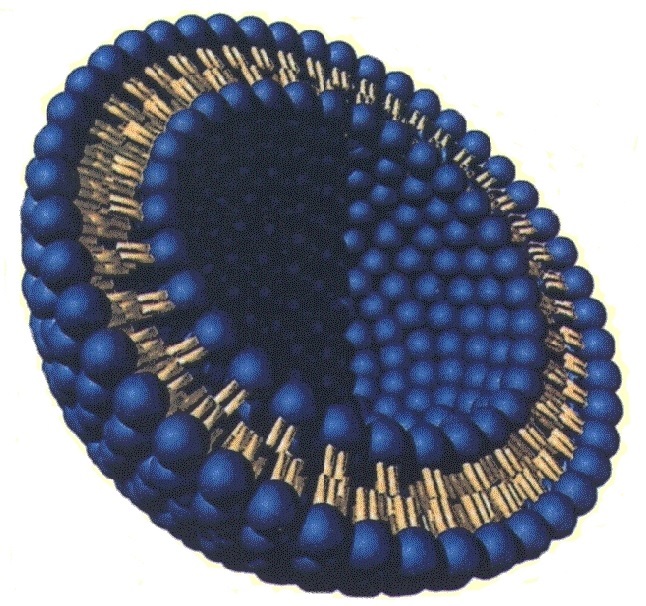
Fig. 4: Cross section through a liposome model
(inside and outside aqueous phases)
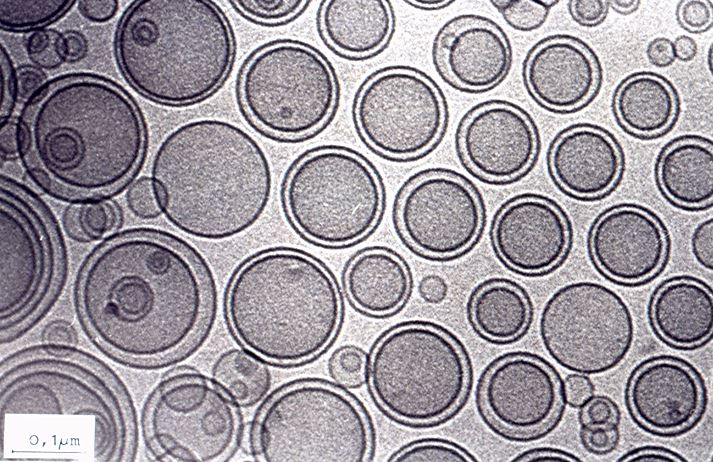
Fig. 5: Liposome dispersion9
The initial conception that liposomes (Fig. 4 and 5) can slip intact through the skin barrier due to their small size of about 50-200 nm has been rapidly disproved after implementing electron-microscopic studies. What actually happens is that the bilayers of the horny layer fuse with the bilayers of the liposomal PC. This is due to the fact that the compounds, similar to the epidermal bilayers10, have two different types of phase transition temperature11:
- Above the temperature of 35 °C the slightly permeable lamellar gel phase of the bilayers coexists with a second phase.
- At about 69 °C the gel phase changes into the more permeable liquid-crystalline phase.
Both the phase transition temperatures are slashed during this fusion process due to the phase transition temperature around < 0 °C of the liposomal native PC. This leads to a short-termed fluidisation and pass-through of the epidermal bilayers. In this way the active agents contained in the liposome dispersions can easier pass through the skin barrier.8
Liquid nanoparticles with PC monolayers (Fig. 6) and comparable particle size analogously accelerate the permeation of lipophilic liquid or solid active agents.12 Aqueous nanodispersions for instance allow a comfortable application of fatty skin care oils without leaving the inconvenient oily sensation on the skin. The dermal efficacy of oils at equal dosage is higher than that of O/W emulsions.
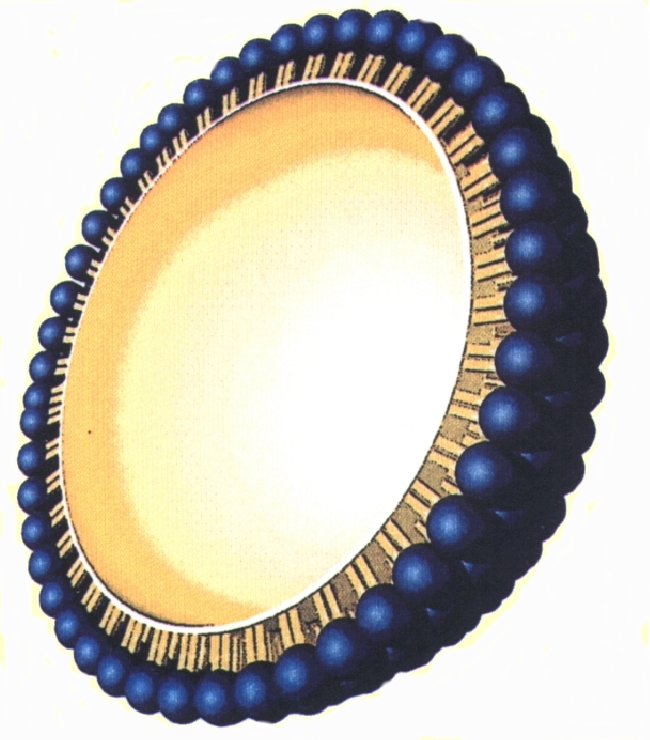
Fig. 6: Liquid nanoparticle ("nanosome") with PC monolayer
(inside lipophilic phase, outside aqueous phase)
The efficacy of transdermal transports and applications finally depends on the PC dosage. By the way, the higher permeability of the barrier can also be externally identified by the temporary and easily measurable increase of the TEWL due to the fact that reciprocally also the elimination of water vapour through the skin is facilitated. In the case of a facilitated passage it is certainly also important to exclude systemic effects of the ingredients of cosmetic products as stipulated in the European Cosmetic Regulation.
Topically applied long-chained lipophilic substances such as vaseline, paraffins and ceresin waxes (ozokerite) however remain on the skin surface, hence they have occlusive effects, lower rigorously the TEWL and subsequently reduce the regenerative capacity13 of the skin. The horny layer underneath swells similarly to the condition under an adhesive bandage and hence also becomes more permeable for topical medical drugs that penetrate into the skin out of the vaseline base. Since this kind of swelling has a temporary wrinkle-reducing effect, paraffins still are ingredients in cosmetic night creams.
Individuals with sensitive skin should be mentioned in this context since they feel a burning sensation after applying cosmetic oil-in-water emulsions. In terms of substances this symptom is unspecific and only depends on hypertonic concentrations of polar, water-soluble substances with usually low molecular mass (example: urea) in the respective preparation. The water-soluble substances permeate the barrier and, in cases where their osmotic pressure is higher than in the environment, trigger a short irritation that often is mistaken as an allergic reaction.
Biology and biochemistry of the horny layer
Since the discovery that cosmetic and pharmaceutical bases without active agents, as for instance in the form of appropriately formulated base creams or ointments, already show considerable clinically significant14 effects on their own the biology and biochemistry of the stratum corneum and its neighbouring skin layers have become increasingly interesting fields of research. They have the potential to develop into singular disciplines, such as corneobiology15 and corneobiochemistry16 due to the fact that coherences and relations are highly complex. A significant finding is the fact that a multitude of dermatoses and cosmetic skin problems already can be treated with appropriate base creams, in other words without any pharmaceutical active agents and the related adverse effects. Already in the past nineties the term corneotherapy17 has been coined for this specific kind of treatment. Curiously enough, the European Cosmetic Regulation bans utilizing such objectively existing dermatological effects in the marketing of the appropriate cosmetic preparations.18
Topically applied pharmaceutical drugs, hygienic- and cosmetic products (skin protection, skin care) of course have effects on the resident microorganisms of the skin flora alias skin microbiome. The causal relations among others in combination with preservatives but also antioxidants and complexing agents in the preparations still are largely unknown. Physiological and microbiome-compatible components will play an increasingly important role in future.
Cosmetic preparations – from the past to the future
During the past hundred and fifty years, the variety of skin care products has proliferated with the chemical synthesis of components and recreated natural substances. Prior to that time, almost everything that nature could provide was tested on the skin. There was no clear differentiation between folk medicine and cosmetics. The most important “preparations” of pre-industrial times are described in the following:
- Particularly popular were makeups and powders with vividly coloured heavy metal compounds such as iron oxides (red, yellow, black), lead carbonate (white), mercury sulphide (cinnabar alias red mercuric sulphide) as well as calcium carbonate (white) and charcoal. In other words, the full range of coloured minerals was ground into powders.
- Cleansing products were important for the skin but also for clothes. For a long time saponin19-rich herbal extracts were dominant with glycoside structures similar to today’s sugar tensides (Fig. 7), as well as potash (from charcoal fires) and the later on produced soaps made of animal or herbal oils with potash- (potassium carbonate) or natron (sodium bicarbonate) solutions.
- Skin care products consisted of animal and herbal lipids, oils and waxes. Popular materials were cetyl palmitate (gained from spermaceti), olive oil and various milk products (for instance from donkeys, goats and cows).
- Herbal extracts and tinctures produced from witch hazel, green and black tea, were used for topical treatments of irritated, cracked skin due to the astringent features of the contained polyphenols and tannic acid.
- Balms and essential oils were used for medical treatments and fragrance purposes. Already in early times people could differentiate between the various stimulating, calming and soothing effects.
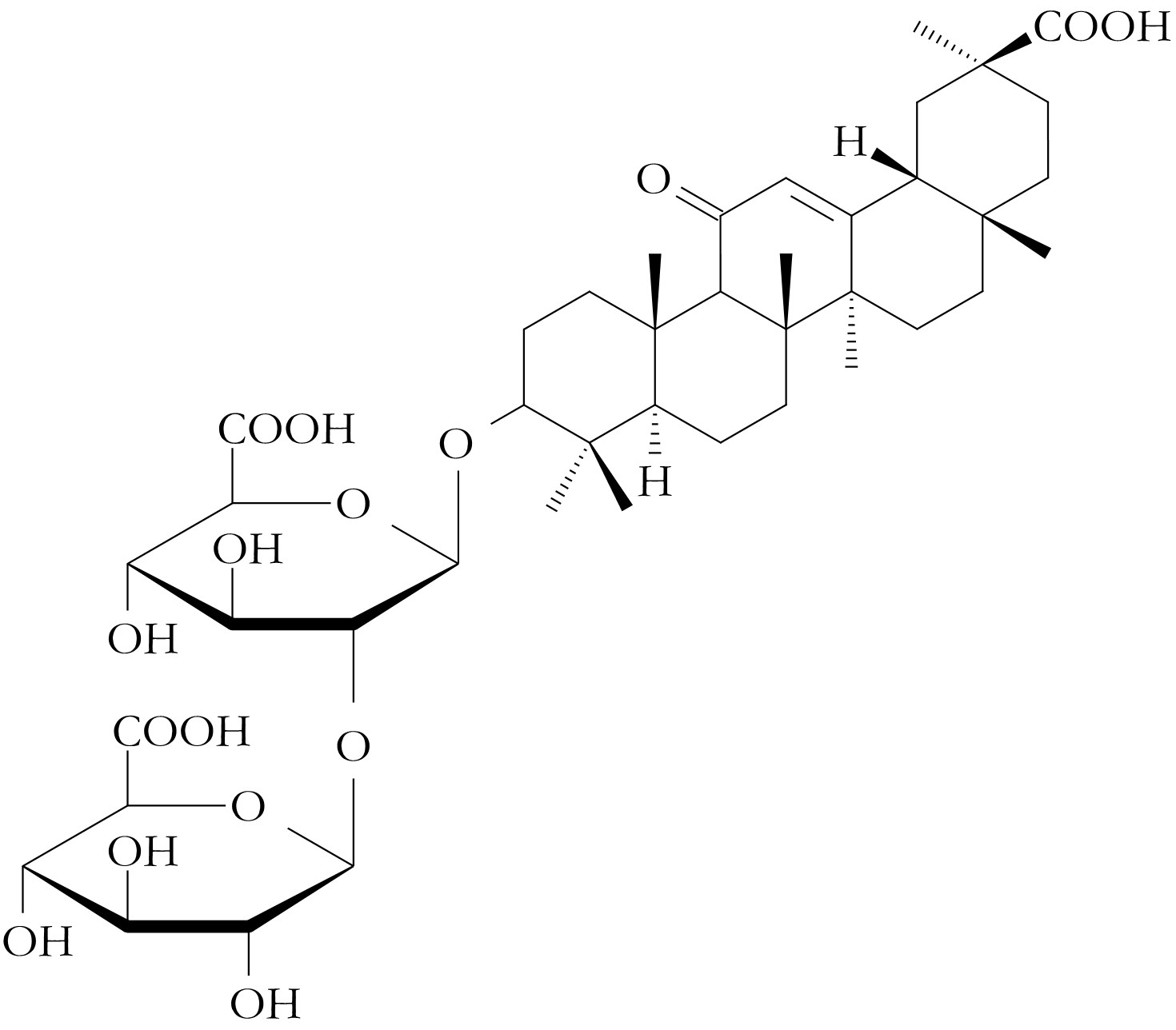 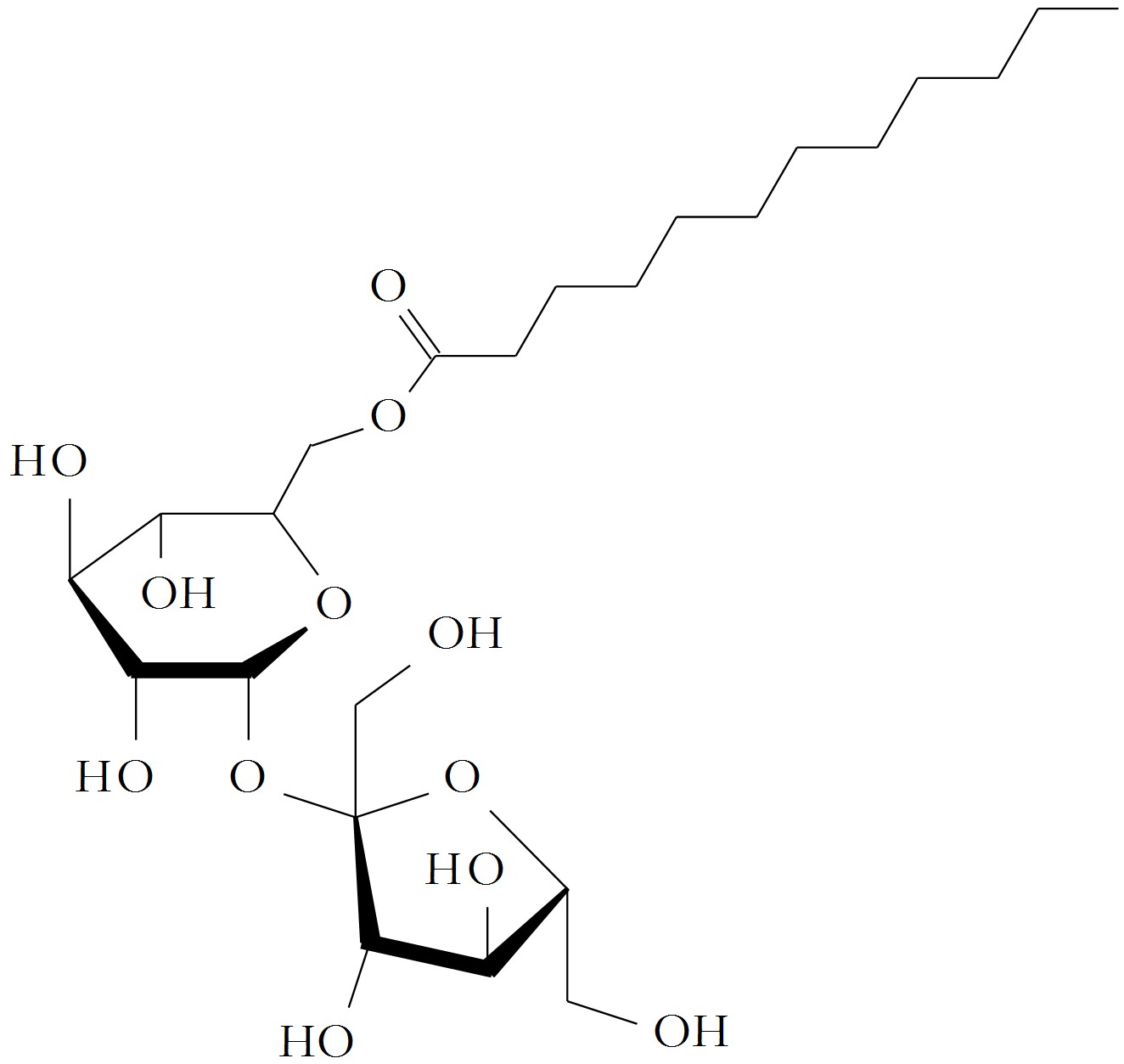
Glycyrrhizin (left), a saponin contained in liquorice root in comparison with sucrose monolaurate (right), a synthetic sugar tenside
Still today, pure lipid substances and their non-aqueous semisolid mixtures (oleogels, milking grease) are used for skin care purposes. Prevalent however are aqueous dispersions of lipid substances that are stabilised with the help of emulsifiers. Emulsifiers basically operate on the same principle as the already mentioned soaps. Added to the variety have been pure aqueous solutions and gels. Novel products also are skin care powders, even if they only are sold on a very small scale. Similar to the non-aqueous fatty preparations these powders are based on the concept that in the absence of water in the product none of the cosmetic additives such as preservatives or emulsifiers are needed to ensure the microbiological and physical long-term stability. Such a reduction of additives also is related to a lower risk of allergenic and irritant features of a product. It should be mentioned that all the preservatives listed in the Cosmetic Regulation20, with no exception, have allergenic potential in spite of the licensing procedures.
Emulsifiers are a practical tool to evenly distribute lipid substances in the form of tiny droplets in water (oil-in-water-emulsion), or vice versa (water-in-oil-emulsion) (Fig. 8), to stabilise them and transport them into the skin.
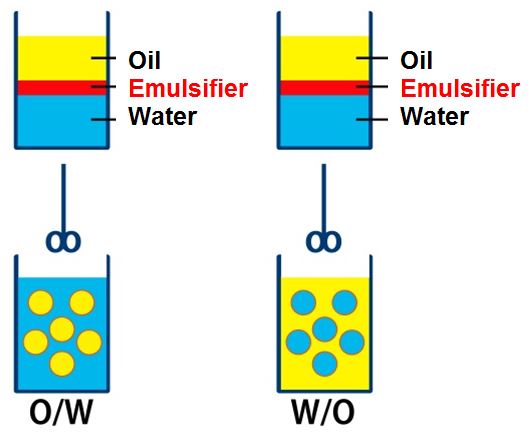
Fig. 8: Production of emulsions
However they also work contrariwise whenever they are reactivated through water during the washing process. Then they re-transport skin care substances but also the natural barrier substances out of the skin. This process, called washout effect, occurs in the case that the emulsifiers are not degraded in the skin or in other words when they are not compatible with the physiology of the skin and also have a high critical micelle concentration (CMC; see below).
Cosmetic preparations meanwhile have been developed into very sophisticated products since a whole variety of criteria for convenient application has been added to the different application features. Skin analysis has become a very important factor in the treatments since the composition of a product is based on the results of a given skin condition. Spreadability, penetrability and physiological availability of the different components increasingly play a role, in particular, if specific cosmetic effects are required. Skin barrier-like physiological components instead of conventional lipid substances and oils are increasingly in demand.21
Skin cleansing
Before now the cleansing of the skin and particularly of the facial skin was a quite simple act requiring water and maybe a bar of soap. Today it has developed into a scientific procedure, which is almost incomprehensible without basic knowledge in chemistry, physics and microbiology. All the more important is it to know about the effects and adverse effects of the procedures applied today. We are no longer talking about the mere fact of eliminating foreign substances from the skin but we also deal with combination treatments including disinfection, conditioning for follow-up treatments and the stimulation of regenerative processes in the skin.
There is a long list of substances that find their way on our (facial) skin every day:
- Natural substances of the body: skin barrier components, skin cells, scabs, glandular secretions such as sebum, sweat, earwax, lacrimal fluid and saliva. Curiously enough, all these components belong to the self-cleansing programme of the skin.
- Natural environmental substances: mineral dusts (mineral clay, silicic acid, salts etc.), herbal substances (hydrocarbons, lipids, waxes, pollen etc.), peroxided hydrocarbons such as peroxyacetyl nitrate (PAN).
- Reaction products of skin components with gases such as oxygen, ozone, nitrogen oxides, sulphur dioxide and chlorine.
- Anthropogenic substances: powders and aerosols (house-, street- and industrial dust including soot particles and polycyclic aromatic hydrocarbons), working substances, household chemicals and fashion jewellery components (silver- and nickel compounds).
- Ingredients in skin care products: lipid substances, active agents, pigments (from lip sticks, makeup, camouflage, powders and mineral-based sun screens), dyes (mascara, eyeliner pencils) and various cosmetic additives.
- Microorganisms and their waste- and metabolic products including enzymes and fatty acids.
These substances can be water-, oil- respectively fat-soluble, completely insoluble or adhesive. These features are crucial for the selection of the cleansing product:
- Tensides in the form of soap bars, cleansing gels or oil-in-water-emulsions have a high dirt-absorbing capacity and usually are most appropriate to remove all kinds of substances.
- Micelle water is a gentle cleansing lotion also consisting of water and low concentrations of tensides. It can be compared with a drop of detergent and a lot of water in the kitchen.
- The term microemulsion is used as a technical name for highly concentrated, tenside-containing formulations in which tensides and water form a homogenous phase. Microemulsions often serve as a base for the preparation of shampoos.
- In the production of adhesive cosmetic products (makeups, camouflage) also short-chained oils (triglycerides, synthetic esters) are used which then are removed with aqueous tensides. An alternative are non-aqueous, tenside-containing oils that form emulsions on the skin after contact with water and thus can easily be removed (2-in-1-products).
- In cases of very sensitive skin and for the skin care of small children either native oils in pure form are suitable or emulsions with high oil content (cleansing milk). In case that the latter mentioned have a lamellar structure due to the hydrogenated phosphatidylcholine base (2-in-1-products, see below) they also are very appropriate skin care formulations. Cleansing milk can also be used for makeup removal.
Tensides & emulsifiers
Tensides, like emulsifiers, are surface-active substances, often with a similar chemical structure so that the terms practically are synonyms. If cleansing products are concerned, the term tenside generally is used whereas the term emulsifiers more often is applied in connection with skin care products. Both of them cause a washout effect which cannot be avoided in the context of cleansing products but is unwanted when skin care products are concerned. A distinguishing feature in terms of quality is the critical micelle concentration (CMC), a physical value informing on the concentration at which surface-active substances combine in water to form so-called assemblies (micelles; Fig. 9)
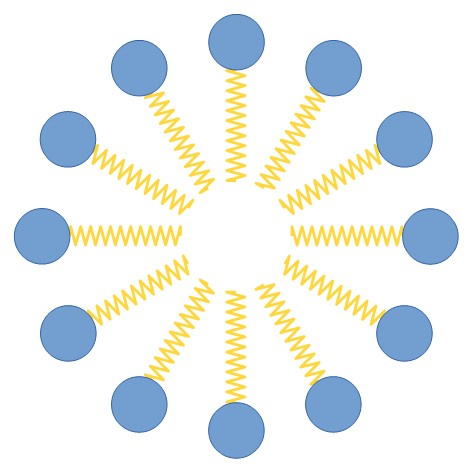
Fig. 9: Micelle model; the hydrophilic heads of tensides are oriented towards the water phase while the lipophilic moieties are inbound.
Tensides tend to have a higher CMC. With increasing CMC the irritation potential also increases. That is the reason why cleansing products should only shortly remain on the skin and immediately be rinsed off (“rinse-off” products). In that respect Sodium Lauryl Sulfate (INCI22) is known to be very aggressive; for reasons of comparison it even is used as a standard irritant in skin tolerance tests of cleansing products.
The advertising messages for cleansing products often are non-specific in terms of product description. A multitude of denominations is circulating. In order to classify the different products with fantasy names it is recommended remembering the INCI codes of specific components and pay attention to their sequence on the labels (≥ 1% going by decreasing concentration, < 1% no stringent order). It takes some practice but then the products can be well rated in terms of suitability and efficacy.
Treatment routines
The above-mentioned cleansing products are used as such or integrated into more complex treatment routines in beauty institutes and medical centres. In these treatments they are applied for pre-cleansings after which more intense (deep-pore) cleansings, a specific conditioning or a regeneration supporting treatment will follow.
The treatments are adapted to the individual condition of the (problem) skin and, where necessary, to the particular requirements of customers and patients. In cases where subsequent treatments are planned, the initially used cleansing products should not contain re-fattening substances such as adhesive siloxanes or surface-active substances with dominant lipid moieties as they will interfere with the following routine.
Skin cleansing frequently is followed by a blackhead and comedo treatment ("thorough cleansing“), often with the help of vaporizers (Vapozon) and/or disinfecting alcoholic lotions. Disinfection after skin cleansings also is a significant step to prepare the skin for the meanwhile rather popular Dermal Needling23 treatment regardless of whether short (cosmetic purposes) or long needles (dermatological purposes) are used. Aqueous polyhexamethylene biguanide solutions (PHMB) have proved successful as disinfection agents. PHMB attacks bacteria and viruses with its cationic structure analogous to the endogenous antimicrobial peptides (AMP). In this context we also speak of an AMP booster. Further disinfecting agents without sensitising potential are 70% (V/V) alcohol and isopropyl (with similar water content).
Peelings
Exfoliating scrubs to peel off parts of the stratum corneum and not only loose skin scales also are administered after a previous skin cleansing. The most important peeling procedures are as follows:
- Mechanical peelings with water-resistant scrubbing agents – preferably made of degradable wax beads. Synthetic polymers (PE; PP, PUR) are on the decline due to the discussions around microplastics. (Sea)Salt peelings are administered in combination with herbal oils; they are advantageous insofar as the salt can be rinsed off with water after the peelings.
- Enzyme peelings contain proteases, mostly bromelain and papain; both of them dissolve the peptide bonds of the topical keratin (keratolysis). Also lipases that cleave the esters of fatty acids are used for this particular type of peeling.
- Chemical peelings with keratolytic effects based on alpha hydroxy acids (AHA) such as glycolic acid and lactic acid (in cosmetic applications), or trichloroacetic acid and phenolic compounds (in dermatological applications). The effects of herbal peelings can be compared to those of analogous chemical agents gained from natural extracts such as willow bark. Sometimes AHA acids already are added to the cleansing gels.
- Microdermabrasion is an instrument-based mechanical peeling procedure in which ultrafine particles made of quartz, aluminium oxide or similar materials are blown onto the skin through a nozzle ("sand blasting“).
- Dermabrasion by means of aqueous liquids squeezed out of a high pressure tool ("water jet treatment“).
The peeling treatment is associated with the concept of stimulating an intense regeneration of the skin with “anti-aging” effects. Long-term observations however point to an increased susceptibility for rosacea and perioral dermatitis after long and repeated intense chemical peelings with fruit acids, in particular in the case of very light skin. As in many other cases, it can be stated that excess skin care measures have counterproductive effects.
Light peelings can be obtained with healing earth masks. In general, masks are used to optimise cleansing treatments (“cleansing masks”). Besides healing earth also kaolin, zeolites and even activated carbon are used to absorb substances from the skin.
Adverse effects
Each cleansing procedure leaves traces in the skin barrier and skin flora. Without applying appropriate skin care preparations after such treatments the skin tends to dehydrate since the TEWL is increased and natural moisturizing substances have been eliminated. Also the susceptibility towards influences of external substances (originating from environment, work and household) and sun radiation is increased. The more intense the cleansing and the more preservatives and disinfectant agents are involved the more the skin flora alias microbiome will suffer. Accordingly, the acid mantle becomes weaker and infections will be facilitated. These mechanisms should be kept in mind when selecting the cleansing agents and the frequency of application.
The pH values of the cleansing agents can be neutral to slightly acidic. If buffer substances (phosphates, citrates etc.) are contained in higher dosage, a pH value of 5.5 should be targeted. In case that only a small quantity or no buffer substances at all are contained, the pH of the preparations can be neglected since the buffer capacity of the skin will adjust to the physiological value in no time. Alkaline cleansing preparations have an irritant effect due to the eliminated acid mantle, a condition to which the skin reacts with an increased formation of barrier components. With a low regenerative capacity of the skin, as occurs in the case of atopic skin, such preparations are not recommended.
Toning & masks
If facial masks are focused on administering active agents rather than on cleansing purposes, a toning of the skin often is fit in between cleansing and mask application. The aqueous tonics condition the skin in a way that it becomes more receptive. For this purpose they contain penetration-enhancing substances such as D-panthenol or also (empty) liposomes based on phosphatidylcholine. The latter mentioned have excellent effects in the case of blemished skin and existing acne. Depending on the composition the tonics can also be used to complete the cleansing treatment or as a light cleansing and refreshment of the skin during the day.
Masks serve as a medium to apply active agents after the cleansing; the actives now can easily pass through the skin barrier. It is differentiated between the following kinds of masks:
- Cream masks (Fig. 10) consist of base creams that are enriched with active agent concentrates (sera). They remain on the skin for about 20 min. Surplus cream will then be removed. Added kaolin and healing earth increase the volume and serve as moisture retainers. Also cooling and moisturizing hydrogels are used in this way.
- Carrier masks either are made of cotton or nanocellulose. They are soaked with active agents and then placed on the face.
- Modelages are hardening masks administered on the facial skin after the application of active agent concentrates, creams or gels. They have occlusive effects and accelerate the penetration of active agents. The powders are mixed with water; besides calcium sulphate they frequently contain diatomaceous earth, kaolin and alginates. After about 20-30 min the hardened mask is taken off in one piece.
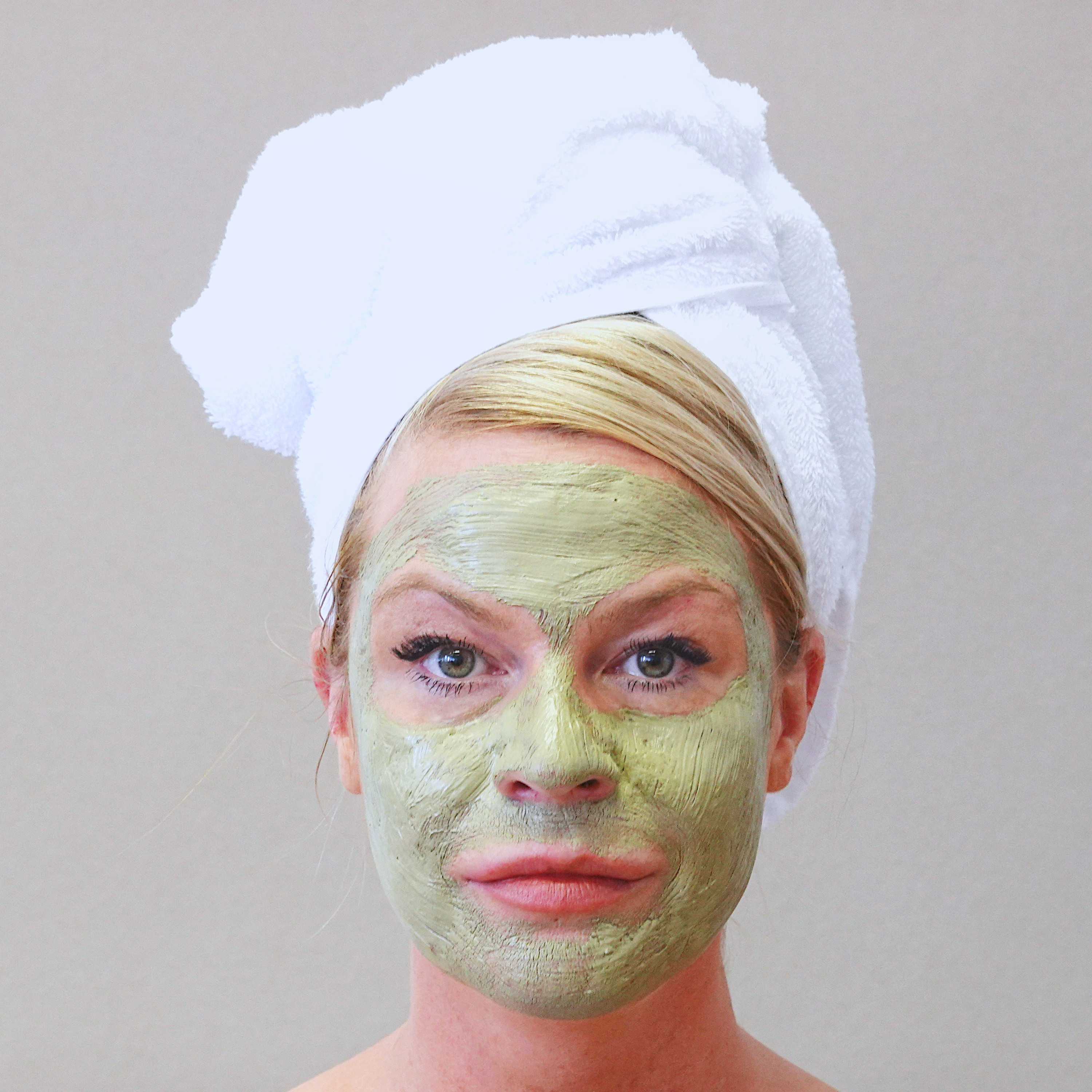
Fig. 10: Cream mask
The following active agents are used in cosmetic masks: sodium ascorbyl phosphate to treat blotchy skin (hyperpigmentation), tranexamic acid (trans-4-(aminomethyl)cyclohexanecarboxylic acid) to treat erythema caused by capillary blood vessels, D-panthenol in the case of irritated skin (Fig. 11). Further active agents are mentioned below.
  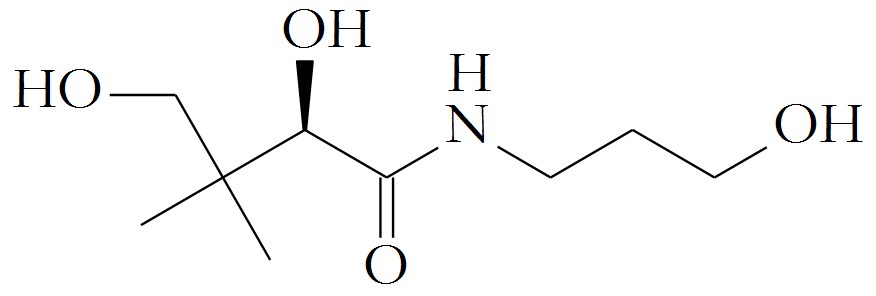
Fig. 11: Examples for active agents in cosmetic masks
(left: sodium ascorbyl phosphate, centre: tranexamic acid, right: D-panthenol)
Skin care and skin protection
A broad range of skin care preparations with various components and forms of application with their particular advantages and disadvantages is available. Haptic, sensorial and practical features of the products have priority. How fast and how long the formulation takes effect but also the bioavailability of the active agents in the skin depends on the specific processing of the components – either in an aqueous solution, a gel or in an emulsion (Fig. 12). Specific cosmetic additives have synergistic or also disadvantageous effects on the skin care- and environmental features of the product. Just to mention a few examples: penetration-enhancing substances increase the availability of active agents; preservatives affect the skin flora; fragrances24 have allergenic potential; other cosmetic additives are non-degradable either in physiological or in environmental-biological aspect. Cosmetic additives can even be efficacious active agents – such as native phosphatidylcholine (with unsaturated fatty acids) that is used to produce liposomes and nanodispersions. Hydrogenated phosphatidylcholine (PC-H)25 with saturated fatty acid allows for lamellar creams with planar bilayers that, seen under the electron microscope (EM) (Fig. 13), are in physical-chemical respect very similar to the barrier layers of the stratum corneum.
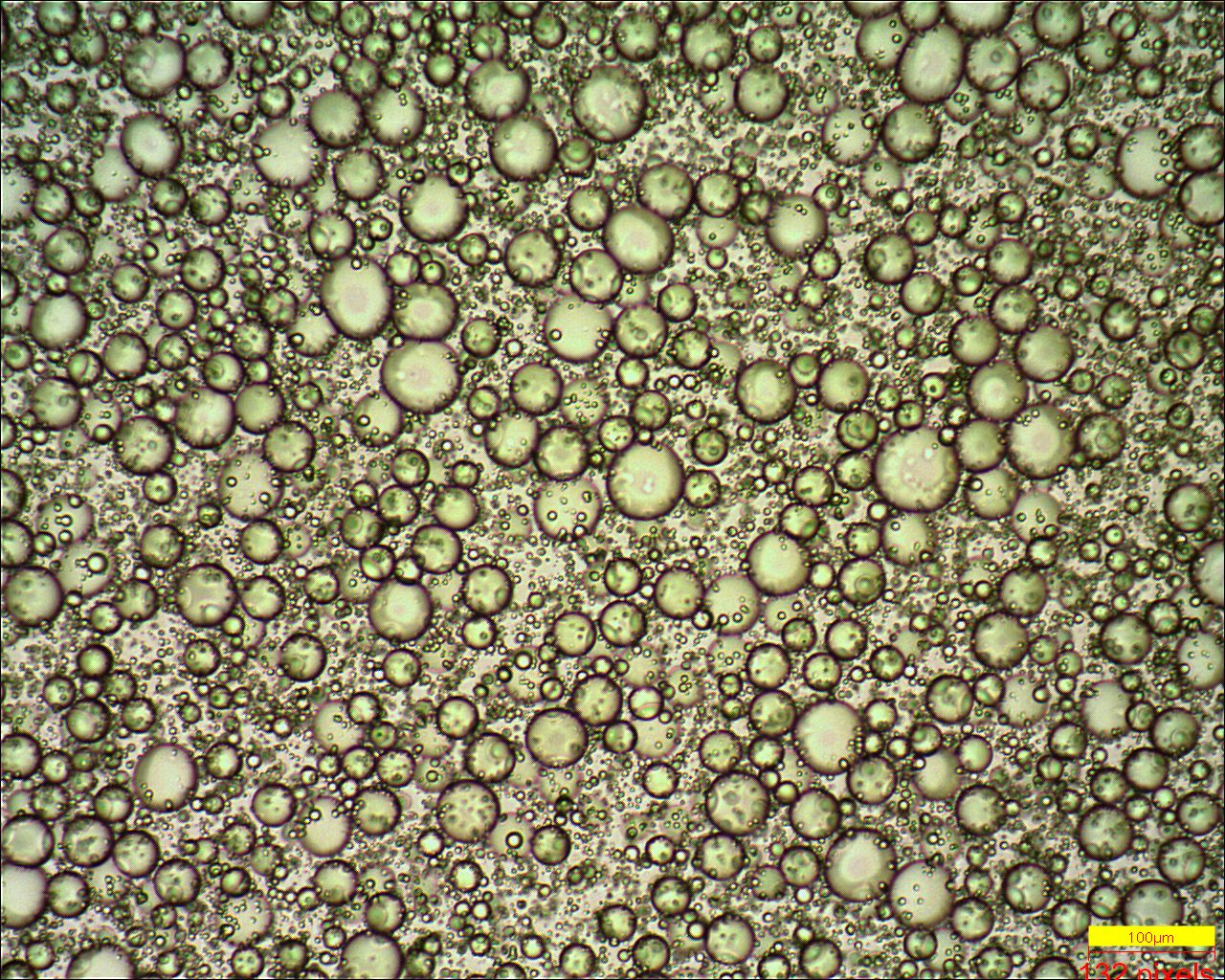
Fig. 12: O/W emulsion26
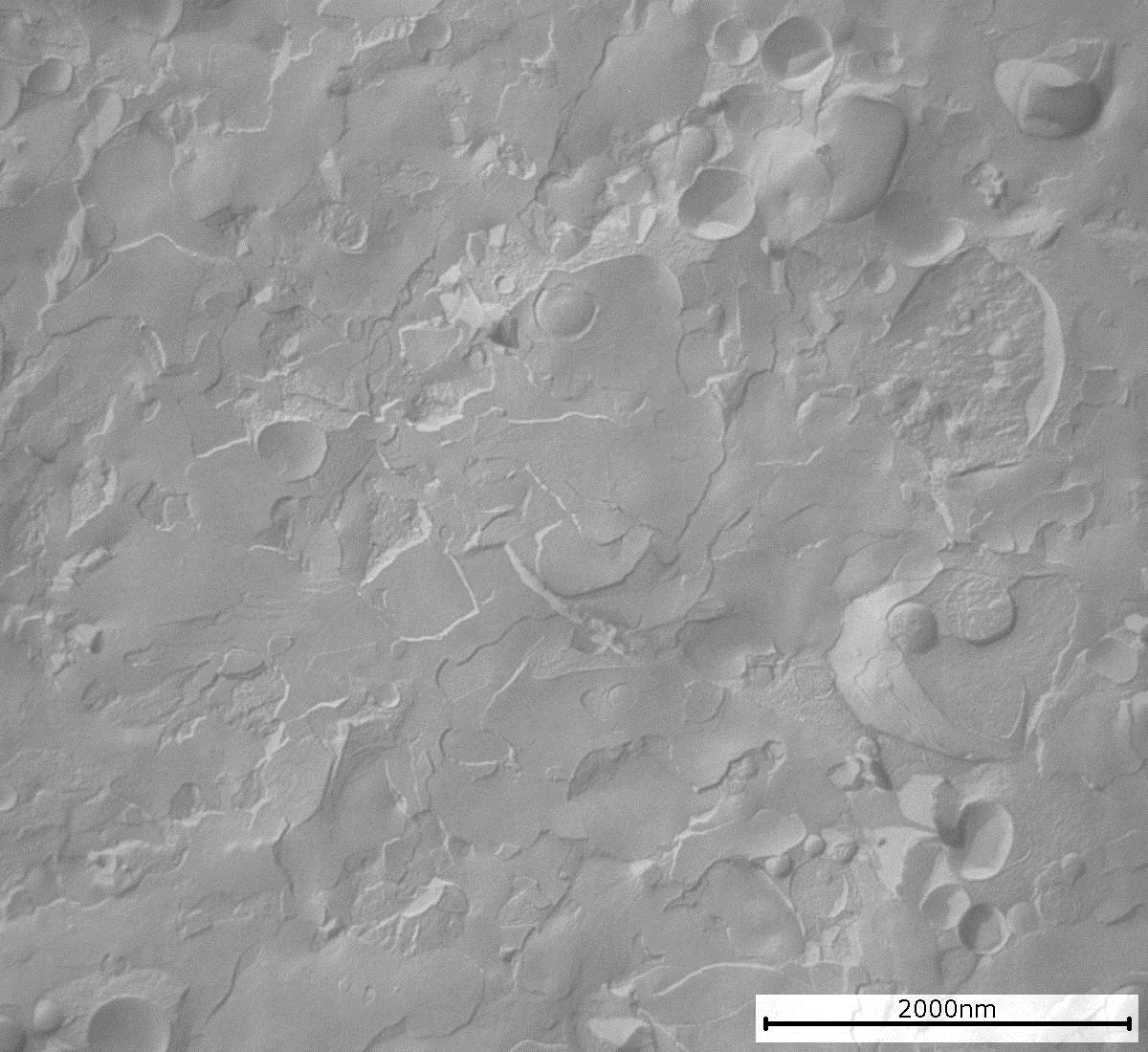
Fig. 13: Lamellar cream27
Lamellar creams cannot be produced with conventional emulsification techniques but require high pressure homogenisation procedures.
pH value
As already mentioned in the chapter “Cleansing agents”, the pH value also is a significant criterion in skin care preparations containing water. In products without buffer it can be around 5-7. In the case that salty components buffer the pH or in other words, keep it at a constant level, the pH should be close to the individual pH value of the skin. If this is not the case, disorders of the skin barrier, the epidermal enzymes or the microbiome can be triggered.
Forms of application
The following table shows examples of forms of application, their compositions and typical applications, where appropriate, with their advantages (A) and disadvantages (D). Further applications result by adding appropriate active agents which are described in the following section. For reasons of completeness of contents also cleansing products are listed in table 1.
Table 1: Forms of application of cosmetic products
|
Form of application
|
Composition of the base28
|
Cosmetic additives
|
Typical applications
|
|
Solutions – aqueous
|
Water
|
Preservatives; alternatively: cans and ampoules (sterile) or low alcohol- and glycol contents
|
Sera, moisturisers, tonics, lotions, antimicrobial dermal needling tonics. Bottled, where appropriate, in spray cans with propellant gas, in dispensers with spraying- or foaming attachment or in pipette bottles
|
|
Tensides in low concentration; preservatives
|
Micelle water for gentle skin cleansing
|
|
Solutions – alcoholic
|
Essential oils, fragrances
|
High alcohol- and isopropyl concentrations
|
Fitness lotions (cooling), inunctions, perfumes. Not appropriate for skin care purposes.
|
|
Solutions – non-aqueous
|
Organic, volatile solvents
|
None
|
Nail enamels
|
|
Essential oils
|
Volatile herbal extracts, such as rose oil alias attar of roses
|
None
|
Perfumes, bath- and cream additives, room fragrances, aromatherapy; D: mind declaration for hazardous substances!
|
|
Fatty oils
|
Native triglycerides and/or synthetic ester oils
|
Antioxidants29 with bound essential fatty acids
|
Massage oils, body oils, baby cleansing, skin care for atopic, very dehydrated and sensitive skin.
|
|
Butter-like natural substances
|
Shea- and cocoa butter contain cholesterol-like phytosterines and wax esters
|
None
|
Re-fattening skin care, frequently local application such as breast- and intimate area. Appropriate for atopic and very dehydrated skin, very economical. D: slow penetration.
|
|
Balms – such as benzoin (alias benjamin), frankincense, myrrh
|
Natural herbal secretions containing essential oils, free acids, aromatic esters and aldehydes
|
Balms and their extracts lose their inconvenient resin features when integrated into nanodispersions30
|
Anti-inflammatory frankincense extracts (boswellic acids) are appropriate active agents in the case of rosacea and acne.
|
|
Hydrogels
|
Water and gelling agents such as xanthan, hyaluronic acid or synthetic carbomers
|
Preservation: see aqueous solutions
|
Hair- and skin care (moisturisers), modular31 base gels, cleansing gels (with tensides), ultrasound media.
|
|
Oleogels – degradable
|
Triglycerides, wax esters, phytosterines
|
Penetration-enhancing substance: phosphatidylcholine
|
Paediatric skin care, skin care for atopic and very dehydrated skin. A: comparably high penetrability.
|
|
Oleogels – mineral-based
|
Paraffin oils, vaseline, ceresin waxes (ozokerite)
|
Frequent consistency agent: silica
|
Ointments, topical pharmaceutical drugs, mascara, camouflage and eye shadow. D: Poor penetration (occlusive), skin-regenerating processes are slowed down (plaster effect).
|
|
Sticks
|
Waxes, pigments, fatty oils
|
Antioxidants
|
Lip(care) sticks, eyeliners and concealers.
|
|
Shaking mixtures
|
Oil and water
|
Usually without emulsifiers (A), preservation: see aqueous solutions
|
Sensitive skin, problem skin, base for pharmaceutical drugs. D: shake before use!
|
|
Emulsions32
|
Oil in water (O/W)
|
O/W emulsifiers, preservatives; preservative-free33: foams (spray cans), water phase frequently hypertonic
|
Gentle skin care (creams, milk). Reduced washout effect due to the use of physiologically compatible emulsifiers such as mono- and diglycerides (tenside-free cleansing milk).
|
|
Water in oil (W/O)
|
W/O emulsifiers, preservatives
|
Rich skin care, skin protection. Compared to O/W frequently smaller water phase and (A) less preservatives.
|
|
Pickering-emulsions34
|
Silica, peptides etc.
|
Skin care; W/O and O/W possible.
|
|
Cold creams
|
Lanolin, phytosterines, bees wax, low amount of water
|
Salts
|
Dry and sensitive skin. Compared to W/O emulsions a more solid consistency.
|
|
Lamellar bases
|
Oils and water in the form of physiological membrane structures
|
Phosphatidylcholine35
|
Skin protection, skin care, modular base creams; lamellar cleansing (milk). Particularly appropriate for dry and atopic skin, frequently in corneotherapeutic applications.
|
|
Microemulsions
|
Water, tensides, oil
|
High concentration of tensides
|
Transparent shampoos, cleansing gels. D: high irritation potential with tensides with high critical micelle concentration (CMC).
|
|
Nanodispersions
|
Water, particles with physiological membranes and encapsulated liquid, lipophilic active agents
|
Phosphatidylcholine
|
Active agent concentrates, sera (where applicable modular) – frequently for problem skin. High penetration of active agents; particularly appropriate for dry and atopic skin as well as scars. A: Particles are physiologically degradable.
|
|
Water, solid lipophilic active agent particles in nano-size
|
Tensides
|
Active agent concentrates, sera, compounds for skin care preparations. A: high penetration of difficultly soluble active agents.
|
|
Liposomes
|
Water, cell-like physiological double membranes with encapsulated hydrophilic active agents
|
Phosphatidylcholine
|
Active agent concentrates, sera (where applicable modular) – frequently for problem skin such as blemished skin, acne, perioral dermatitis. A: high penetration of active agents.
|
|
Suspensions
|
Micronized active agents in cream base
|
Where applicable, consistency agents
|
Ointments, UV protection (mineral-based: ZnO, TiO2). A: improved availability of active agents.
|
|
Waxes, seed flours in cream bases
|
Where applicable, consistency agents
|
Mechanical peelings plus skin care ("2 in 1“). Waxes are gentler for the skin than seed flours.
|
|
PE, PP, PU plastic particles in cream bases
|
Where applicable, consistency agents
|
Mechanical peelings, industrial skin cleansing. D: microplastics problems
|
|
Salts or sugar, fatty oils or oil mixtures
|
To be mixed before the treatment
|
Whole body peelings plus skin care ("2 in 1“). A: peeling bodies are removed with water after the treatment.
|
|
Pigments, dyes, polyamide fibres
|
Mascara base
|
Mascara (decorative eye cosmetic)
|
|
Foundations
|
Emulsions with high pigment content
|
Emulsifiers; alternatively: lamellar bases
|
Make-up
|
|
Powders
|
Minerals, pigments
|
Extenders: native flours, polyamides
|
Powder, compact powder
|
|
Minerals, healing earth
|
Are mixed with water before the treatment
|
Rinse-off- cleansing- and skin care masks
|
|
Algin, diatomaceous earth
|
Calcium sulphate: the powders are mixed with water before the treatment
|
Hardening occlusive modelages (20-30 min). The active agent concentrates are administered before application of the modelages.
|
|
Bromelain, papain; diatomaceous earth, kaolin
|
Are mixed with water before the treatment
|
Enzyme peelings (10-30 min)
|
|
Soda, citric acid, fragrances or dyes
|
Media for pills and granules, such as starch
|
Bath additives (bubbly). D: mind pH value!
|
Cosmetic active agents
Preventively protecting, regeneration-supporting and anti-inflammatory activities of active agents are in the focus of interest. All in all, this also is the typical toolset to fight premature skin aging. More and more emphasis is now put on "sustainability“. A short description of the functions of cosmetic active agents is following:
- Skin protection against
- physical influences (radiation, mechanical impacts and erosion),
- chemical influences (household, working place and environment),
- microbial influences (individual microbiome and exogenous microorganisms).
- Treatment and recovery of
- barrier disorders,
- cornification disorders,
- connective tissue- and vascular disorders,
- irritations, allergies and inflammations,
- pigment disorders.
- Compensation of endogenous deficits, such as enzyme defects (see below).
- Preventive care
- sustainable (= without long-term adverse effects),
- accompanying the indication (see below).
- Optical treatments – camouflage with decorative products.
Cosmeceuticals are a group of cosmetic active agents that have been documented in clinical studies. They virtually are niche substances between pharmaceutical and cosmetic active agents. It should however be mentioned that there are no universally valid rules for the classification of active agents into the group of cosmeceuticals.
Documentation
In order to ensure high availability and efficacy at the targeted point of action, cosmetic active agents have to penetrate into and possibly also permeate the skin barrier (e.g. vitamins). In vitro measured action is insufficient in this regard. Reproducible studies and significant causalities here are preferable however often not available. They also should show local action without any systemic effects. Also required are conformity with the German Cosmetic Regulation (Kosmetikverordnung – KVO) and a documented safety (safety report). Substances that are banned in the Cosmetic Regulation such as hormones are not allowed for use, pharmaceutical active agents can be used to a certain extent, if the condition of the skin will be improved, stabilised and skin disorders eliminated. Just to mention a few examples: D-panthenol (provitamin B5) in the case of a predisposition to erythema, azelaic acid ≤ 1% (Fig. 14) in the case of a predisposition to blemished skin, acne, rosacea and perioral dermatitis, tranexamic acid to whiten the skin and reduce erythema, pirocton-olamine (INN) alias 1-hydroxy-4-methyl-6-(2,4,4-trimethylpentyl)-2(1H)-pyridone monoethanolamine salt (Fig. 14) in the case of exfoliative scalp. It should however be added that the German Cosmetic Regulation bans any sales promotions mentioning wound healing (D-panthenol), acne treatment (azelaic acid) and antimycotic effects (pirocton-olamine).
 
Fig. 14: Examples for pharmaceutical drugs in cosmetic preparations
(left: azelaic acid, right: pirocton-olamine)
Anti-inflammatory active agents (examples):
- 15-lipoxygenase substrates – ω-3 and ω-6 fatty acids such as linoleic acid (from herbal oils, phosphatidylcholine), γ-linolenic acid (evening primrose, borage) and α-linolenic acid (linseed, kiwi, rosehip, phosphatidylcholine [soy]). The metabolites of essential fatty acids originating from the natural 15-lipoxygenase activity of the body have anti-inflammatory effects.
- 5-lipoxygenase inhibitors – 3,4-dihydroxycinnamic acid (caffeic acid), curcumin (curcuma alias turmeric rhizomes), hyperforin (St.John’s wort alias amber), 3-O-acetyl-11-keto-ß-boswellic acid (frankincense extract in vitro36). The 5-Lipoxygenase activity causes the formation of leukotrienes from the endogenous arachidonic acid which, among others, triggers allergic and inflammatory reactions.
- Antibacterial substances such as azelaic acid ≤ 1% (occurring in cereals); in this particular case it inhibits the growth of anaerobic germs.
- Protease inhibitors – boswellic acids (frankincense extract in vivo37) inhibit proteases.
- Macrophage-activating substances – phosphatidylserine (soy, endogenous) activates the immune system.
Regenerative active agents (examples):
- Retinoids – among others, they stimulate growth factors: vitamin A (retinol) and ester, retinal (aldehyde), provitamin A (β-carotene und carotenoids). The effective metabolite is vitamin A-acid (INN: Tretinoin) which, however, is banned for cosmetic applications. Use: skin tightening, blemished skin (acne). The Federal Institute for Risk Assessment (Bundesinstitut für Risikobewertung – BfR) recommends a limitation to facial applications.
- Vitamin B range – among others, stimulation of growth factors. Examples: vitamin B3 (niacinamide: anti-inflammatory in the case of blemished skin resp. acne), provitamin B5 (D-panthenol: irritated skin, soreness)
- Vitamin E improves the epithelialisation and the moisture-retaining capacity of the skin.
- Sphingosine-1-phosphate – inhibition of keratinocyte proliferation: skin care in the case of psoriasis.
- Zinc salts (≤ 1%) – participate in the formation of oxidoreductases such as superoxide dismutase (SOD).
- Isoflavonoids – phytohormones, bonding to local estrogen receptors.
- Gamma linolenic acid – in the case of delta-6-desaturase enzyme defects38 (atopic skin).
- Growth factors & messengers39 – various peptide structures.
- Category of mainly temporarily effective substances: wrinkle reducing oligopeptides, spilanthol [(2E,6Z,8E)-N-(2-methylpropyl)-2,6,8-decatrienamide], hyaluronic acid as well as skin tightening extracts and active agents such as centella asiatica, kigelia extract, saponins, N-acetyl-glucosamine. They often are contained in products advertised for anti-aging purposes.
Protective active agents
- Barrier active components such as long-chained fatty acids, cholesterol and phytosterines, ceramides, hydrogenated phosphatidylcholine (PC-H), squalane/squalene. On top of that additional lipids in the form of triglycerides and wax esters. Note: the lipid content of creams today still is an important criterion among dermatologists and cosmeticians. Without information on the type and concentration of the used emulsifiers, this indication however is useless since the related washout effect cannot be assessed.
- Linoleic acid – ceramide I substrate (important for the elasticity of the skin barrier).
- Moisturisers such as glycerine, glycols, urea, and amino acids of the NMF, mineral salts and topically active filming polysaccharides which are permeable to water vapour such as hyaluronic acid, alginates and cellulose derivatives. Amino acids of the natural moisturizing factor (NMF) are natural radical scavengers.
- UV filters transfer radiation into heat. In various countries they are classified as "medical skin care“, and thus subject to particularly intense examinations. Sun protection factors have to be measured in a way that they eliminate the radiation which is not eliminated by melanin. This ensures that the melanin formation still is slightly stimulated and vitamin D is formed. Additional antioxidants in sun protection products are counterproductive for the melanin formation; apart from this, they are short-lived during radiation exposure and higher concentrations support the radical chain formation.
- Antioxidants: the vitamins A, E, and C, isoflavonoids, polyphenols and derivatives in appropriate (!) concentrations. Strong antioxidants are counterproductive in cases where healing and pigmentation processes are occurring as they are radical (!) processes.
- Tyrosinase inhibitors suppress the melanin formation – frequently antioxidants, applied to prevent hyperpigmentation. Liposomal ascorbyl phosphate (alias vitamin C phosphate) in a concentration of ≤ 1% effectively inhibits the pigmentation during laser treatments and stimulates the collagen formation.
- Tranexamic acid (≤ 2%) stabilises the topical blood vessels (rosacea, erythema) and inhibits the melanin formation. It is particularly popular among individuals with Asian skin with pristine white skin appearance.
Essential elements to be considered when applying active agents are: a skin diagnosis with appropriate probes, camera and recording of the customer’s history; the treatment with a reduced number of active agents or in other words, only the individually required amount; focusing on causality (cause and effect) and adequate dosage; as well as the tolerability of the end products. In this context it is not important whether product components are of natural or synthetic origin.
The purity of components, the physiological compatibility, known and uncritical metabolism (without long-term effects) and the compatibility with the microbiome are important factors.
In cases where the sustainable preventive skin care is accompanying or subsequent to a medical therapy, which actually happens quite frequently, it is recommended to use base creams that follow the regulations of the pharmacopoeia or the German Ordinance on the Operation of Pharmacies (Apothekenbetriebsordnung – ApoBetrO)40 to avoid a change of system. This ensures high therapy conformity and optimal skin care accompanying the indication. The pharmaceutical- (therapy) and cosmetic active agents (skin care) can be matched as shown in the examples in table 2.
Table 2: Matching cosmetic active agents for selected pharmaceutical drugs resp. their indications
|
Indication (examples)
|
Pharmaceutical drugs (examples for therapy)
|
Cosmetic active agents (skin care)
|
|
Hormone treatments
|
Oestrogens
|
Isoflavonoids ("phytohormones")
|
|
Atopic skin
|
Corticoids
|
Barrier-active substances: ceramides, phytosterines, phosphatidylcholine
|
|
Acne
|
Vitamin A acid (INN: tretinoin)
|
Vitamin A; 15-lipoxygenase substrates, azelaic acid
|
|
Rosacea
|
Metronidazol
|
Azelaic acid & protease inhibitors
|
|
Inflammations
|
Antibiotics
|
15-lipoxygenase substrates, protease inhibitors, D-panthenol
|
|
Itching
|
Antihistamines
|
Amides: urea, allantoin, secondary carboxylic acid amides
|
Modular systems facilitate the compounding of pharmaceutical drugs (pharmacy) and cosmetic active agents (beauty institutes) into base creams.
Anti-Aging
Lately introduced active agents against particular environmental pollution ("anti-pollution“) only show marginal benefits. Effective skin protection at the workplace, skin care with barrier active and non-occlusive components, the moderate antioxidative effects of amino acids (NMF) and a gentle skin cleansing (tensides with low CMC) are completely sufficient. Pollution caused by max. 10 µm ("PM10") and 2.5 µm large respirable particles ("PM2.5") has been on the decline for years.41
Similar applies to many anti-aging active agents and their only marginal effects on the skin compared to other factors such as exercise, balanced nutrition, balanced mind (reduced stress) and avoiding excessive consumption of alcohol and cigarettes.
Dermatological cosmetics
Lamellar (base)creams are an example for bases that are suitable for both extemporaneous formulations (magistral preparations42) of dermatological applications and for individualised cosmetic preparations made of active agent relevant components, in other words preparations that perfectly interact and hence are a sustainable solution for skin problems. A decisive factor in this context is that the skin barrier is repaired and maintained with physiologically beneficial components already during therapy so that later recurrences triggered by external germs, allergens and chemicals can be prevented. This kind of therapy exactly corresponds to the concept of corneotherapy43 which at its beginning was referred to as water-dermatology44. Specific characteristics are the clinically proven efficacy in the case of barrier disorders and the fact that it is absolutely free of adverse effects in comparable dermatological indications. Dermatological cosmetics in accordance with the corneotherapeutic concept can be characterised as follows:
- No active agent cocktails with a multitude of low dose components that finally only serve for marketing purposes.
- Limitation to a minimum of cosmetic additives.
- No cosmetic additives that require additional additives: example: polyethylene glycols (PEG) and their derivatives that are used as emulsifiers or consistency agents but additionally have to be stabilised by antioxidants.
- No emulsifiers that cannot be degraded in the skin. Exception: use in rinse-off products such as skin cleansing agents.
- No surface-active substances that, despite of a disordered skin barrier, leave a pleasant sensation on the skin and thus lull consumers into a false sense of security. Example: representatives of the group of re-fattening substances in skin cleansing products such as PEGs and long-chained silicones.
- No occlusive substances unless occlusive conditions are required due to dermatological aspects. Occlusion leads to skin swellings and reduced regenerative capacity of the skin. Examples: paraffin oil, vaseline (petrolatum) microcrystalline wax, ceresin wax (ozokerite).
- No preservatives with allergenic potential.
- No ingredients with suspected endocrine adverse effects from the substance classes of sun screens, preservatives or denaturing substances (example: phthalic acid diethylester). No ingredients that impair the experience of pain in the skin. Example: laureth-9.
- No fragrances. Particularly essential oils contain allergenic components or can form such in the case of radiation- and atmospheric oxygen exposure – e.g. ascaridol, an allergenic terpene endoperoxide that forms in tea tree oil.
- No strong complexing agents that also block out physiological trace elements in the skin and are persistent in terms of biodegradability. Example: EDTA.
- No recommendation of physical, chemical or medical skin treatments that overcharge the regenerative capacity of the skin after reapplications or cause irreversible adverse effects. Example: routine chemical peelings.
- No sales promotion for compounds or treatments that are objectively unnecessary for the skin or overcharge the skin in the long-term. Example: daily bathing of small children while using tensidic compounds.
- Moderate dosage of strong antioxidants that block out the oxidoreductases of the skin microbiome or the radical healing processes.
Frequently the question is asked whether natural cosmetics can be used for corneotherapeutic applications. The answer here is quite simple: natural cosmetics also have to meet the above-mentioned criteria. Natural cosmetics containing natural preservatives with allergenic effects similar to their synthetic counterparts are not suitable for corneotherapeutic applications. Natural components of dermatological cosmetics however are welcome – such as shea butter (Fig. 15) and phospholipids. Physiological compatibility is an important criterion.
 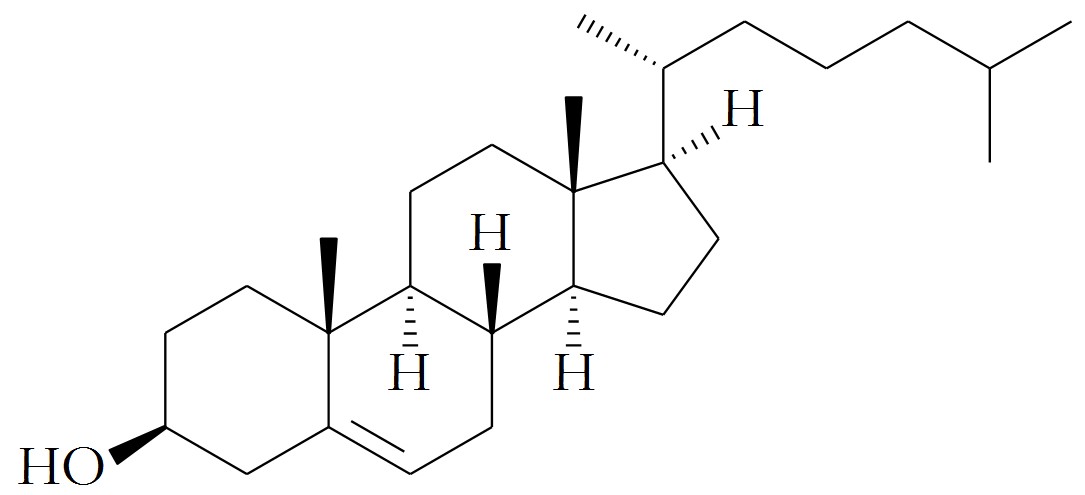
Fig. 15: β-Sitosterol (left), a component of shea butter, compared to the skin barrier component cholesterol (right)
The attribute "dermatologically tested“ is no indication for dermatological cosmetics. It only says that a dermatologist had tested the preparations for tolerance. It does not imply any assessment criteria and assessment results.
Adjuvant and extended corneotherapy
Clinical studies45 indicate that not only barrier disorders such as atopic dermatitis respond to corneotherapeutic treatments. Also cornification disorders and dermatoses can be successfully treated with adjuvant46 corneotherapy. Even base substances such as lipids and filming agents can have beneficial effects in this context.47
As already described above, the skin barrier can be adjusted with physiological penetration-enhancing substances either to a pass-through mode or to protective features, a fact which is very important for the active agent transport but also for the natural skin protection. The term “extended corneotherapy”48 has been coined for this specific treatment technique
One of the major advantages of corneotherapy is that it is largely free of adverse effects – in contrast to topical pharmaceutical drugs. Applied as a preventive measure corneotherapy can extend the period free of complaints and reduce or even obviate the use of conventional dermatic products. A precise skin diagnosis and a broad experience of the composition of skin care preparations and their ingredients however are requirements for the successful corneotherapeutic treatment. The longer duration of treatment can possibly be seen as a disadvantage, though.
Medical devices
In this context the topical medical devices49 should be mentioned. We are dealing here with compositions that are largely similar to cosmetic preparations. Just as for cosmetic products18 an uncritical skin contact is required for their licensing50 in class I. The intended purpose of medical devices mainly falls into the category “identification, prevention, monitoring, treatment or soothing of diseases”. Medical devices can have therapeutic effects – however not in a pharmacological sense such as topical pharmaceutical drugs that inhibit, stimulate or otherwise influence the metabolic activities and biological processes (in the skin). Topical products of class I hence more or less shall modify the physical-chemical skin condition in a way that a therapeutic benefit will result. The only difference between topical medical devices of class I to similarly composed cosmetic preparations is that soothing and healing effects of the medical devices can be utilised for sales promotion purposes. The quality requirements for such compounds often are not in accordance with the standards listed in the German Cosmetic Regulation (Kosmetikverordnung – KVO), though.
Summary
The focus of skin care is on the stratum corneum or in other words, the top layer of the skin. On the one hand it should protect the body against exogenous influences on the other hand it should be penetrable for well-documented cosmetic active agents integrated in appropriate carriers. State of the art are lamellar, liposomal and nanodisperse formulations.
Metabolism and care of the skin are a very complex subject matter and its understanding requires a high interdisciplinary knowledge in biology, biochemistry and chemistry. Sustainable skin care takes this into account and largely avoids counterproductive components. Skin analysis is a prerequisite for causally acting compounds that can partly be used in a modular way. Bases for the simultaneous use in dermatological extemporaneous formulations and for cosmetic adjuvant skin care or the prevention of certain skin conditions are an optimal solution (Fig. 19). Physiology is not necessarily at odds with chemistry in this case.
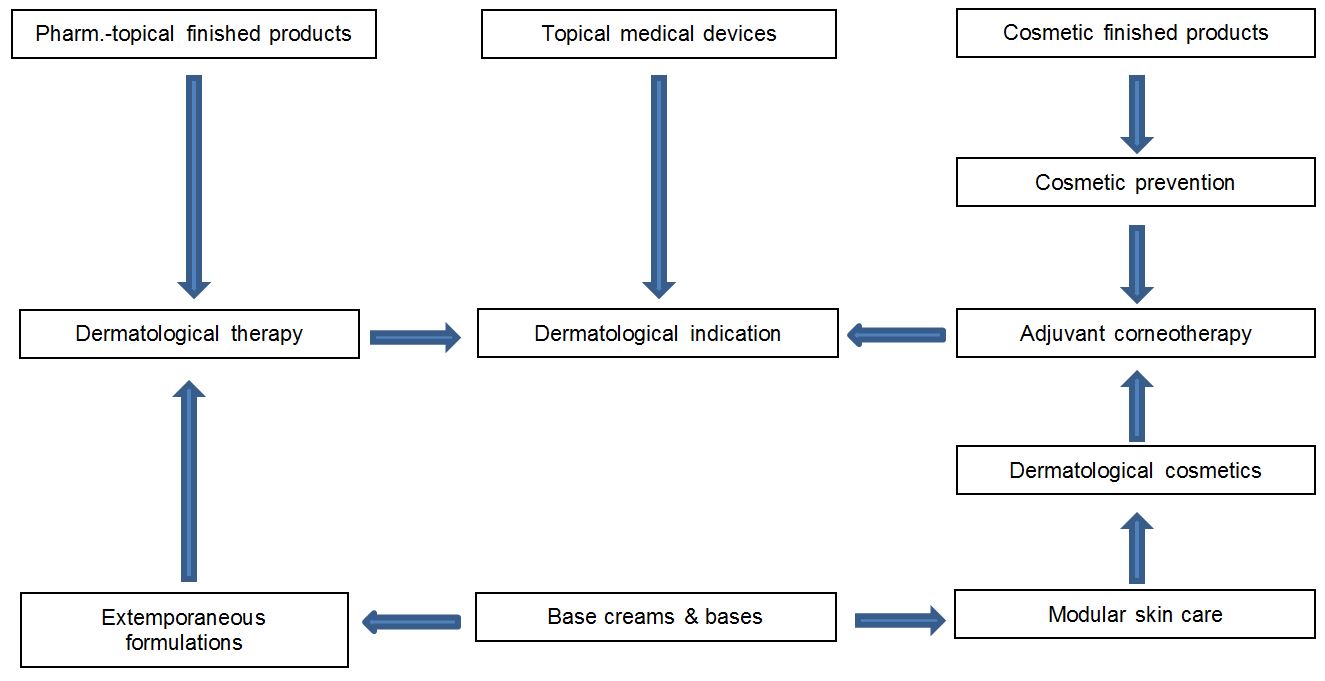
Abb. 16: Interaction of dermatology and cosmetics
References and annotations
- from Sgbeer – Own Work, CC BY-SA 3.0, https.//commons.wikipedia.org/w/index, php?curid=8534406, called on 2.10.2020 and translated.
- L. Landmann, Anat Embryol 1988,178,1-13.
- Ceramides, a many-faceted family of amides, result from acylation of the amino alcohol sphingosine with long-chained and partly functionalised fatty acids.
- E. Kownatzki, Kosmetische Medizin 2000, 21(1), 26-27.
- F. Meyer und E. Meyer, Arzneimittel-Forschungen, Band 9, 1959, 8, 516–519.
- Biological cell membranes mainly consist of phospholipids, in particular phosphatidylcholine (PC). The structure and size of the PC liposomes is similar to the cells.
- Native phosphatidylcholine (PC) is mainly gained from soy lecithin with liquid chromatography technique after degumming and de-oiling treatment. About 65% of the fatty acid composition is linoleic acid. Further components are alpha-linolenic acid and palmitic acid, among others.
- H. Lautenschläger, Handbook of Cosmetic Science and Technology 2006, S. 155-163 (Ed.: A. O. Barel, M. Paye und H. I. Maibach), CRC Press, Boca Raton.
- The electron-microscopic imaging shows cryofixated liposomes of different size with one (uni-lamellar) and several (multi-lamellar) bilayers in 1% aqueous dispersion.
- Molar ratio: Ceramides/cholesterol/long-chained fatty acids = 1 : 0.9 : 0.4. Another, earlier known composition was based on the ratio of 1 : 1 : 1.
- I. Plasencia, L. Norlén und L. A. Bagatolli, Biophysical Journal 2007, 93, 3142-3155.
- H. Lautenschläger, medical Beauty Forum 2016, 2, 12-16.
- G. Grubauer, P. M. Elias und K. R. Feingold, J. Lipid Res. 1989, 30, 323-333.
- J. Lübbe, Dermatology 2000, 200, 285-286.
- C. Keck, Journal of Aesthetic Surgery 2020, 13, 132-142.
- H. U. Jabs, Ästhetische Dermatologie (mdm) 2013, 1, 14-19.
- N. Tabata, K. O'Goshi, Y. X. Zhen und A. M. Kligman, Dermatology 2000, 200, 308-313.
- European Cosmetic Directive (EC) No. 1223/2009.
- Saponins – the term is derived from the Latin word sapo for soap – consist of a lipophilic and water-insoluble steroid-, steroid alkaloid- or triterpene structure and thereto bonded hydrophilic water-soluble sugar molecules. Substances that simultaneously are lipophilic and hydrophilic are called amphiphilic substances, a property that saponins have in common with emulsifiers and tensides which also implies their cleansing features. Today saponins are again on the market in the form of Indian soap nuts.
- German Cosmetic Directive, annex V (list of preservatives licensed for cosmetic preparations).
- H. Lautenschläger, Beauty Forum 2020, 8, 52-55.
- INCI = International Nomenclature of Cosmetic Ingredients.
- The skin is perforated which stimulates the regeneration. It is a frequently used technique for the treatment of scars.
- According to the German Cosmetic Directive, section 19 and annex III, the following allergenic components of perfumes have to be quoted separately in the list of components: Benzyl Alcohol, Amyl Cinnamal, Cinnamyl Alcohol, Citral, Eugenol, Hydroxycitronellal, Isoeugenol, Amylcinnamyl Alcohol, Benzyl Salicylate, Cinnamal, Coumarin, Geraniol, Hydroxyisohexyl 3-Cyclohexene Carboxaldehyd, Anise Alcohol, Benzyl Cinnamate, Farnesol, Butylphenyl Methylpropional, Linalool, Benzyl Benzoate, Citronellol, Hexyl Cinnamal, Limonene, Methyl 2-Octynoate, Alpha-Isomethyl Ionone, Evernia Prunastri Extract, Evernia Furfuracea Extract.
- PC-H can be produced from native soy PC through catalytic hydrogenation. Its phase transition temperature is similar to that of dipalmitoyl phosphatidylcholine (DPPC) of 42 °C. The fact that the phase transition temperature of PC-H is in the range of the transition points of the epidermal bilayers predestines lamellar creams for the specific function of filling the gaps in the epidermal bilayers. This function plays an important part in the physiological skin protection. The critical micelle concentration (CMC) of PC-H is 4.6 x 10-10 mol/l. The CMC of typical O/W emulsions for comparison: ca. 10-3 mol/l. That is the reason why the wash-out effect of lamellar creams is minimal. PC-H is physiological and without irritation potential.
- 27% oil in water (O/W emulsion).
- Electron-microscopic imaging after freeze fracture;; INCI: Aqua, Caprylic/Capric Triglyceride, Pentylene Glycol, Hydrogenated Lecithin, Butyrospermum Parkii Butter, Glycerin, Ceramide NP, Squalane.
- Bases and cosmetic additives can overlap in some cases.
- In the presence of unsaturated fatty acids antioxidants are also used in other routes of administration.
- R. H. Müller, C. Schmidt, R. Trebeljahr, H. Lautenschläger und C. M. Keck; M1078, AAPS Annual Meeting, San Diego/USA, 2014, 2-6 November
- The term modular involves that active agent concentrates (sera) are mixed on the spot with bases such as base creams and -gels or are applied on the skin one after another.
- Varieties: multiple emulsions W/O/W and O/W/O.
- H. Lautenschläger, medical Beauty Forum 2017, 2, 12-16.
- Pickering emulsions contain finely dispersed and stabilizing solid matter in the interfaces between water- and oil phase. Examples: silica, peptides.
- Applications with phosphatidylcholine (PC) usually are free of preservatives since PC inactivates the majority of preservatives listed in the annex V of the German Cosmetic Directive (Kosmetikverordnung – KVO). Apart from that it is beneficial for the microbiome of the skin as it neither damages it nor can it develop resistances. PC applications hence are particularly suitable for the sensitive and problem skin.
- H. P. Ammon, Planta Med. 2006, 72 (12), 1100-1116.
- H. Lautenschläger, medical Beauty Forum 2015, 4, 12-16.
- H. Lautenschläger, Beauty Forum 2017, 1, 52-54.
- H. Lautenschläger, medical Beauty Forum 2012, 2, 16-18.
- German Ordinance on the Operation of Pharmacies – Apothekenbetriebsordnung – ApoBetrO.
- German Federal Environmental Agency, Interpretation of particulate matter data, Air quality in Germany, effective December 2016.
- H. Lautenschläger, Beauty Forum medical 2020, 2, 22-25.
- A. M. Kligman, Journal of Cosmetic Science 2011, 33 (3), 197-209.
- A. M. Kligman, Bioengineering of the Skin: Water and the Stratum corneum 1994, S. 251-255 (Hrsg.: P. Elsner, E. Berardesca und H. I. Maibach), CRC Press, Boca Raton.
- K. Suvorova, Les Nouvelles Esthétiques (Russische Version) 2004, 4, 28.
- J. Lübbe, American Journal of Clinical Dermatology 2003, 4 (9), 641-654.
- K. De Paepe, J. P. Hachem, E. Vanpee, D. Reseeuw und V Rogiers, Acta Derm Venerol 2002, 82, 184-186.
- H. Lautenschläger, Ästhetische Dermatologie (mdm) 2007, 3, 8-16.
- Directive 93/42/EWG.
- H. Lautenschläger, Kosmetik International Top Medical 2020, 1, 42-45.
*) Published in: Hans Lautenschläger, Die Haut und ihre Pflege – Physiologie und Chemie im Einklang, Chemie in unserer Zeit 2021, 55 (5), 306-319. Copyright © 2021 Wiley-VCH GmbH. Reproduced with permission. Finale Version: https://onlinelibrary.wiley.com/doi/abs/10.1002/ciuz.202000057
|

